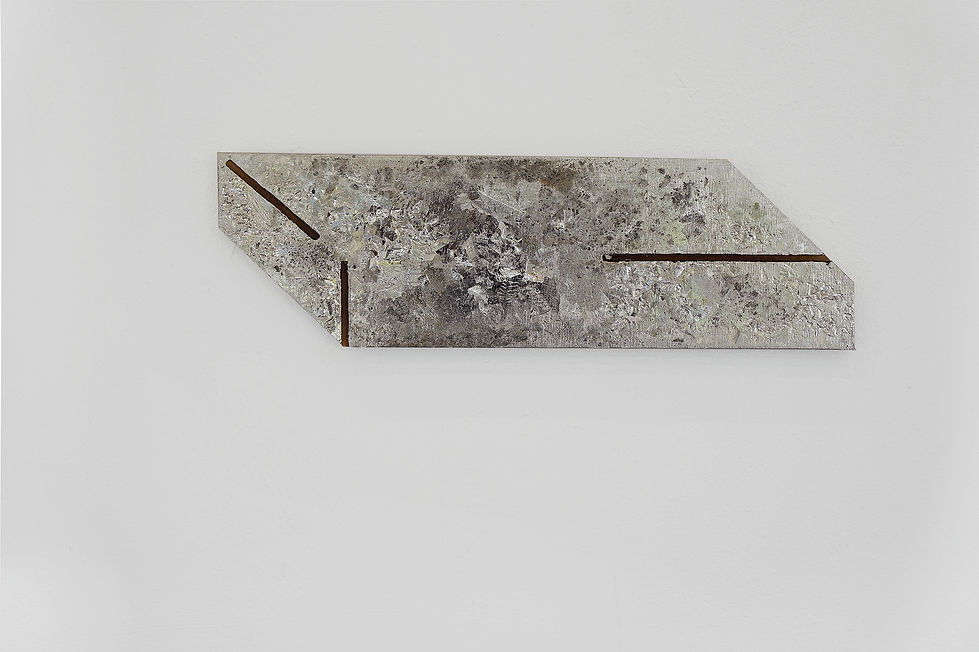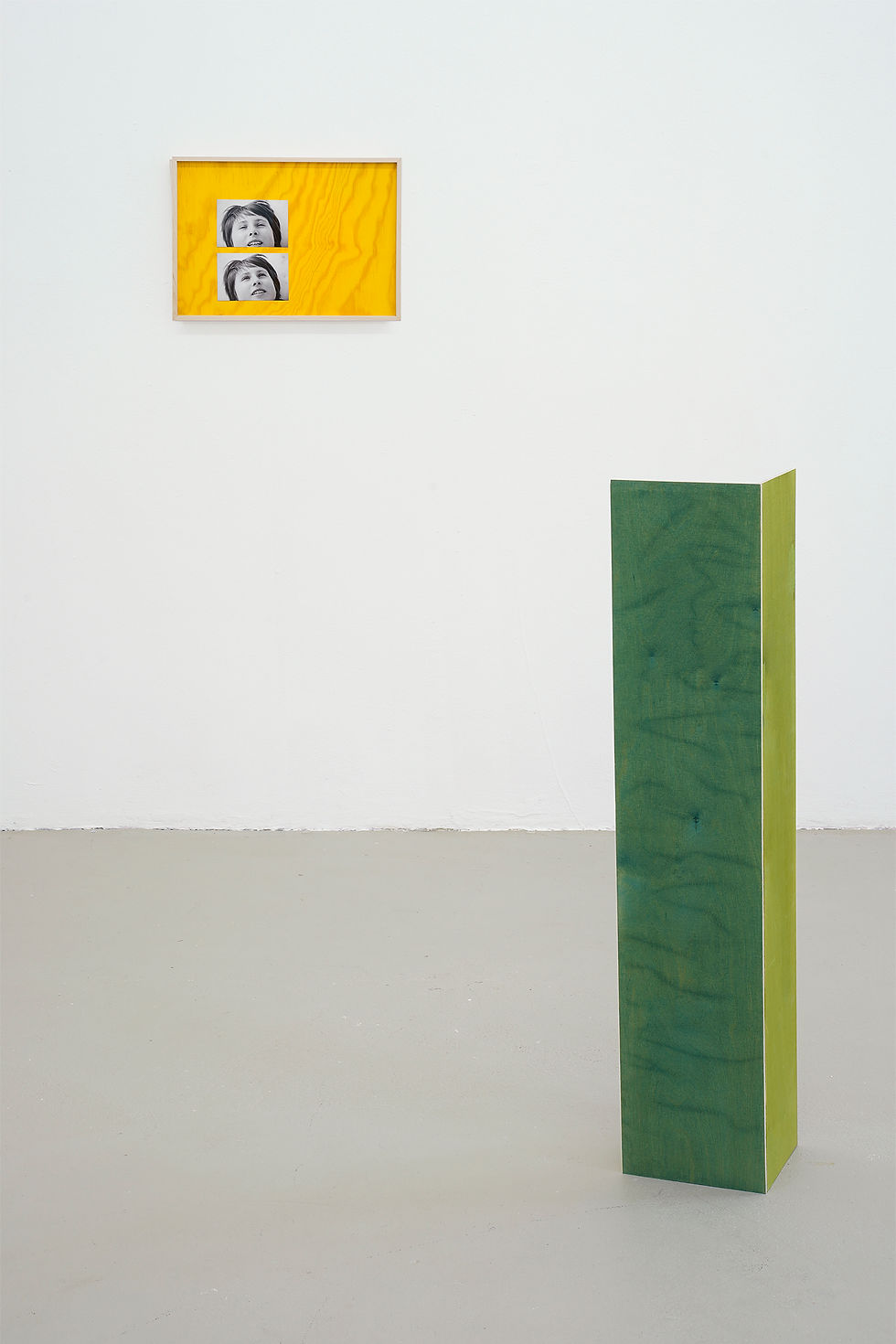YOU BELONG TO YOUR OWNER (Toccata con Durezze e Ligature)
Group show “Ici et là-bas”
at Goethe Institute Paris
in collaboration with Deutsche Börse Photography Foundation, 2019
Curated by: Katharina Scriba and Amy Beckmann
4 B/W prints, glass, W. 50 cm H. 75 cm
sun-bleached fabric, metal mounting, W. 120 cm H. 195 cm
Wooden board, ink, erosive procedures, W. 49 cm H. 87 cm
Oval wooden board, ink, erosive procedures, W. 171 cm H. 110 cm
YOU BELONG TO YOUR OWNER (Toccata con Durezze e Ligature)
Group show “Ici et là-bas”
at Goethe Institute Paris
in collaboration with Deutsche Börse Photography Foundation, 2019
Curated by: Katharina Scriba and Amy Beckmann
4 B/W prints, glass, W. 50 cm H. 75 cm
sun-bleached fabric, metal mounting, W. 120 cm H. 195 cm
Wooden board, ink, erosive procedures, W. 49 cm H. 87 cm
Oval wooden board, ink, erosive procedures, W. 171 cm H. 110 cm
DreamsBecomeDaydreams
Group show Mirror Map by Particolare, Fondation Opale, CH, 2025, curated by Valentinas Klimašauskas and Kolja Gläser
Snow-melting outdoor object, bismuth, Ø 55 cm, 2024

Leave Society Leave Society Leave Society Leave Society Leave Society Leave Society Leave Society Leave Society Leave Society Leave Society Leave Society Leave Society Leave Society Leave Society Leave Society Leave

A series of screen prints comprising archival photographs and bird recordings captured with a trail camera.
Group show Riddles for longing, Atelier Bardaf, Brussels and Flimsy Fictions, Salon am Moritzplatz, Berlin
Organized by Maximilian Schröder and Sophie Fitze
Seven planets seven days of the week, screen print, aluminum frame, 49 x 70 cm, 2025
Birds of Prey, screen print, aluminum frame, 49 x 70 cm, 2025
Jay's Life, screen print, aluminum frame, 49 x 70 cm, 2025
Untitled TV, screen print, aluminum frame, 49 x 70 cm, 2025






Hier muss der Eingang sein
Group show If not friend, why friend shaped?, Bismuth, 7x100cm; Bismuth 28x54cm, 2024, Spoiler Berlin




Nothing could I write or think about this work that Sophia didn't put into her writing and speaking in such a way that there is nothing to add. So I’ll call this work Eisenhut.
Bismuth, 57 x 81 cm, 2023 , Group show, Studio Hannibal, Berlin





A Knight’s Willing Suspension of Disbelief

When I look at the image of Hans Holbein* I think of two different literary characters: the Tin Man from the Wizard of Oz, who wants nothing more than a heart. The other is the Steadfast Tin Soldier who braves all dangers to reach his coveted love and yet is ultimately thrown into the fire where he melts into a heart-shaped lump.
To defend oneself against the symbolic figure of death that seizes one, is on the threshold of no longer completely giving in to this idea of an image, resisting its destined path. The figure defends itself against the attacker, who only thereby becomes real. In the intertwining of the two armored figures, a twisted form is created that results in a stalemate. As both simultaneously strike each other down, they appear frozen (as if in a pillar of salt), crystallized in the moment of complete physical entanglement. As they kill each other, they also seem to give each other support. Perhaps this is how they find comfort in their togetherness, frozen in the moment, outlasting place and time.
*Drawing after „Bilder des Todes“, Hans Holbein d. J., woodcut, The Knight, 1512
– Lorenz Liebig
















What happens when time does not hold still? When it can no longer be ordered chronologically, but is layered on top of each other in such a way that new time forms emerge?
MAGNA MAGMA shows photographs from Mika Schwarz’ archive. On wooden panels stained in different colors, almost sculptural-looking portraits of teenagers can be seen in black and white, embedded in the colorful grain of the wood. Blurred images of everyday interior scenarios are mixed in, in between home-grown crystals that grow on doorknobs, pans, and scarves; on things that seem like placeholders of an undefined everyday life. Instead of outlining the mood of one’s own youth, however, the various types of images and objects stand side by side as freely associated principles of form – or rather form together, as a reciprocal reaction of self-chosen form and chemical formula. Time, this becomes visible here, begins to move and proliferate. So what opens up when matter and time wrap around each other and continue to overlap?
In MAGNA MAGMA, the temporal dimension of archived photographs enters into a dialogue with the formal principle of crystal. Contrary to its spiritual charge and its promise of healing, the focus here is on the rulebook of its growth though: as a kind of pre-programmed mechanism. Just as the atoms of the crystal take possession of trivial objects, the photographs become the resonating bodies of a view of the past that repeatedly covers the present. This gaze can double, blur in places, disappear, or suddenly reappear. It transforms the certainty of recognizing oneself or a certain moment into a fictitious pattern of constantly changing forms. In this way, identification processes detach themselves from their supposed origins. The focus is no longer on the individual image that freezes in the moment, but on the emblematic mass that melts as soon as time and matter come into contact with each other. What opens up here as a period of time has neither result nor origin, is intuitive and yet regulated; it does not follow chance or a self-imposed authorship, but the rules of atomic growth. By thus showing the past as a process of growth and a moment of transition – exemplified by the life phase of youth – MAGNA MAGMA ultimately formulates an archaeology of the present; an exploration of moments of identification that do not lie completed in the past, but are always in transition.
Agnieszka Roguski

















Sempre avanti!
As part of the exhibition series Public Fictions, a collection of performative garments, conceived in dialogue with and realized by fashion designer and product developer Daniel Juhart, was created.
The garments are based on synthetic tanning processes carried out by Bayer in Leverkusen and show scans of leather samples (ca. 1950) that were created in the course of these processes. Excerpts from the recipes for this tanning process, developed around 1930, can be found in the accompanying publication and refer to the chemical waste stored in the Dhünnaue contaminated site (now Neulandpark), which polluted and pollutes people and the environment.
The collection was activated by dancers from the Crossing Creeks Square Dance Club e.V. Leverkusen as part of the exhibition.





Item falls, autumn falls, 2021

I: UV print on thermoplastic sheet, jug,
W. 52 cm, H. 65 cm, D. 13 cm, 2020
II: UV print on mould, plant, glass,
W. 55 cm H. 172 cm D. 24 cm, 2020
III: pencil on stone slab,
W. 60 cm H. 60 cm D. 2,5 cm, 2020
IV: engraving on wooden board,
W. 40 cm. H. 30 cm. D. 5 cm , 2020
Artist feature, Synchron Magazine, visual art and fiction, Pilot Issue, 01/ 2021

Notes on footnotes
__________
1 Geologists and archeologists, those instruments of consciousness who are engaged in
reawakening the memory of the world, have one guiding principle for their work. It is called the law of stratification, but it is as simple as falling downstairs – and, indeed, resembles it in that both are inevitable results of the work of gravity. (Hawkes, Jacquetta: A Land, 1991)
2 30.07.1998 1700. Wodurch entsteht eigentlich Wahrheit, im Text? Durch nichts Einzelnes, durch kein Detail. Nicht durch die Selbstdeklaration der Sache als Realität, Kunst, Trash, Reportage, als Wirklichkeit oder auch als Wahrheit, eh klar. ( Rainald Goetz: Abfall für alle, 2003 )
3 In all these legends human beings have seen themselves melting back into rock, in their imaginations must have pictures the body, limbs and hair melting into smoke and solidifying into these blocks of sandstone, limestone and granite. Some feeling that the converse of this idea arises from sculpture. (Hawkes, Jacquetta: A Land, 1991) Some things that fly there be—Birds—Hours—the Bumblebee—Of these no Elegy. Some things that stay there be—Grief—Hills—Eternity—Nor this behooveth me. (Emily Dickinson, 1859)
4 One goal of material culture studies based on the idea of recursivity is the illumination of difference between the messages on the surface of things and the models of society enacted by people’s use of them or, more colloquially, the differences between what an item of material culture promises its users and what it delivers, especially when what is delivered has no apparent connection to an object’s function. (Potter, P.B. Critical Archaeology: In the ground and on the street, 1992)
Does a flawed hypothesis allow us to gain insight into the society around us?
The object world, every single object, can be perceived as an artifact of a present time, shaking off its cultural and physical location1. The beholder thus becomes an archaeologist who tries to trace back its origin, its purpose and its owner.
Perception is becoming a hypothesis at this point and objects are no longer vessels, not carrying any lasting content within them.2 The aspect of time is inherent to them and they hold several timelines that cross, diverge and overlap. Objects are appearing as delayed and premature fictions, never in touch with the present moment but unfolding its weight as real time within fiction.3
Item falls, autumn falls are time sculptures in which time itself is considered as a medium in order to make these objects visually collide with their timelines4 - a plant aging away, while its mold takes on photographic attributes, a jug revealing its surface as a repetition of references, a watchman watching.





YOU BELONG TO YOUR OWNER
GfZK - Galerie für Zeitgenössische Kunst Leipzig, 2019
Sun-bleached awning fabric on stretcher, pencil, ink, gouache, W. 185 cm H. 235 cm
Sheet metal object, ink, pencil, abrasion processes, glass, W. 85cm H. 75 cm D. 35 cm
Tile fragment, abrasion processes, cast in resin mold, W. 30 cm H. 30 cm D. 3,5 cm
Table object, ink, abrasion processes, glass W. 80 cm H. 130 cm D. 60 cm
Double-sided wooden board, ink, metal wall mounting ,W. 90 cm H. 90 cm
2 B/W prints, glass, metal frames, W. 50 cm H. 75 cm
Sun-bleached fabric, metal wall mounting, W. 120 cm H. 180 cm



























